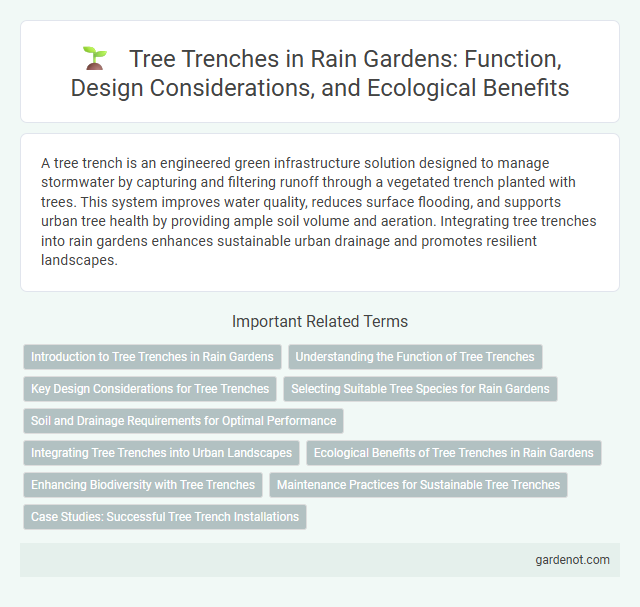A tree trench is an engineered green infrastructure solution designed to manage stormwater by capturing and filtering runoff through a vegetated trench planted with trees. This system improves water quality, reduces surface flooding, and supports urban tree health by providing ample soil volume and aeration. Integrating tree trenches into rain gardens enhances sustainable urban drainage and promotes resilient landscapes.
Introduction to Tree Trenches in Rain Gardens
Tree trenches are engineered planting systems designed to manage stormwater by combining soil filtration with tree root absorption in rain gardens. These trenches typically feature a gravel-filled basin beneath permeable soil layers, allowing for efficient infiltration and pollutant removal before water reaches the groundwater. By supporting healthy tree growth and reducing urban runoff, tree trenches contribute significantly to sustainable urban stormwater management.
Understanding the Function of Tree Trenches
Tree trenches serve as engineered bioretention systems designed to manage stormwater runoff by capturing, filtering, and infiltrating rainwater through soil and root zones. These trenches support urban tree growth by providing essential water while reducing surface flooding and improving water quality through pollutant removal. Integrating permeable media and structural storage, tree trenches enhance groundwater recharge and mitigate the impact of impervious surfaces in urban landscapes.
Key Design Considerations for Tree Trenches
Tree trench design prioritizes soil permeability, trench dimensions, and structural support to maximize stormwater infiltration and protect urban trees. Incorporating a gravel or sand layer enhances water filtration while ensuring sufficient volume and depth accommodates root growth and prevents soil compaction. Proper edge treatments and durable geomembranes help control runoff direction and preserve trench integrity under varying weather conditions.
Selecting Suitable Tree Species for Rain Gardens
Selecting suitable tree species for rain gardens requires prioritizing native, drought-tolerant trees with deep root systems that enhance infiltration and reduce runoff. Species such as Bald Cypress (Taxodium distichum), Red Maple (Acer rubrum), and Swamp White Oak (Quercus bicolor) are effective choices due to their high water tolerance and ability to thrive in variable moisture conditions. Proper species selection enhances rain garden performance by improving soil stability, promoting pollutant uptake, and supporting local biodiversity.
Soil and Drainage Requirements for Optimal Performance
Tree trenches require well-draining, loamy soil with high organic matter to support healthy root growth and effective stormwater infiltration. The soil must maintain a balance between water retention and permeability, typically exhibiting infiltration rates between 0.5 and 1.5 inches per hour. Proper soil composition and layering enhance drainage capacity, prevent waterlogging, and promote nutrient absorption for optimal tree trench performance.
Integrating Tree Trenches into Urban Landscapes
Tree trenches enhance urban landscapes by capturing stormwater runoff and improving groundwater recharge. Strategically placed along sidewalks and streets, these trenches support healthy tree growth while reducing urban heat island effects. Integrating permeable materials and native plants further optimizes their ecological and aesthetic benefits in city environments.
Ecological Benefits of Tree Trenches in Rain Gardens
Tree trenches in rain gardens enhance stormwater management by increasing infiltration and reducing runoff, which mitigates urban flooding and improves groundwater recharge. These structures support diverse microbial communities and promote soil health, fostering a natural filtration process that removes pollutants such as heavy metals and nutrients from stormwater. By providing habitat connectivity and supporting native vegetation growth, tree trenches contribute to urban biodiversity and ecosystem resilience.
Enhancing Biodiversity with Tree Trenches
Tree trenches significantly enhance biodiversity by creating a habitat that supports diverse plant species and local wildlife, including pollinators and beneficial insects. These engineered green infrastructure elements improve soil health and water quality by filtering stormwater runoff, promoting a balanced ecosystem. Integrating tree trenches within urban landscapes helps establish interconnected green corridors that foster greater ecological resilience and species diversity.
Maintenance Practices for Sustainable Tree Trenches
Regular inspection and removal of debris maintain optimal water infiltration in tree trenches, preventing clogging and promoting healthy root growth. Periodic replacement of mulch and adjustment of soil levels support nutrient availability and prevent surface erosion. Integrating native plants and ensuring proper irrigation enhance the sustainability and ecological benefits of tree trenches.
Case Studies: Successful Tree Trench Installations
Tree trench installations have demonstrated enhanced urban stormwater management and improved groundwater recharge in diverse case studies, exemplified by projects in Portland, Oregon, and Minneapolis, Minnesota. These installations effectively reduce runoff volume and pollutant loads while supporting healthy tree growth in constrained urban environments. Empirical data from these case studies highlight substantial benefits such as decreased drainage infrastructure costs and increased urban canopy coverage.
Tree trench Infographic

 gardenot.com
gardenot.com